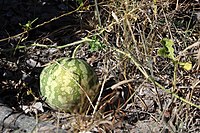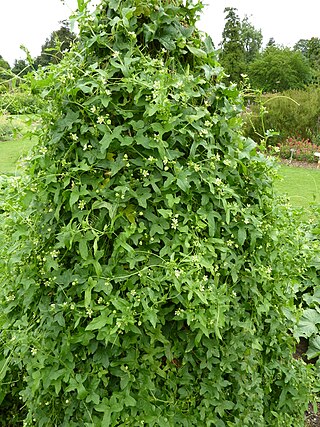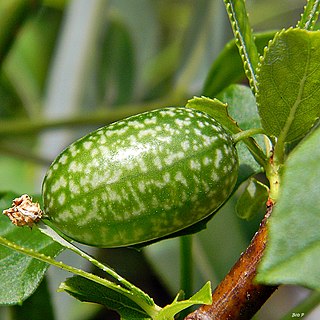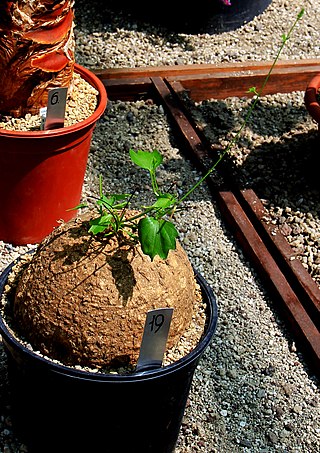The Cucurbitales are an order of flowering plants, included in the rosid group of dicotyledons with a cosmopolitan distribution, particularly diverse in the tropics. The order includes shrubs and trees, together with many herbs and climbers. One major characteristic of the Cucurbitales is the presence of unisexual flowers, mostly pentacyclic, with thick pointed petals (whenever present). [1] The pollination is usually performed by insects, but wind pollination is also present (in Coriariaceae and Datiscaceae).
Contents
- Begoniaceae
- Begonia
- Cucurbitaceae
- Acanthosicyos
- Blastania
- Citrullus
- Coccinia
- Corallocarpus
- Cucumella
- Cucumis
- Diplocyclos
- Gerrardanthus
- Kedrostis
- Lagenaria
- Momordica
- Mukia
- Oreosyce
- Peponium
- Trochomeria
- Zehneria
- References
The order consists of roughly 2600 species in eight families. The largest families are Begoniaceae (begonia family) with around 1500 species and Cucurbitaceae (gourd family) with around 900 species. These two families include the only economically important plants. Specifically, the Cucurbitaceae (gourd family) include some food species, such as squash, pumpkin (both from Cucurbita ), watermelon (Citrullus vulgaris), and cucumber and melons ( Cucumis ). The Begoniaceae are known for their horticultural species, of which there are over 130 with many more varieties.
The anthophytes are a grouping of plant taxa bearing flower-like reproductive structures. They were formerly thought to be a clade comprising plants bearing flower-like structures. The group contained the angiosperms - the extant flowering plants, such as roses and grasses - as well as the Gnetales and the extinct Bennettitales. [2]
23,420 species of vascular plant have been recorded in South Africa, making it the sixth most species-rich country in the world and the most species-rich country on the African continent. Of these, 153 species are considered to be threatened. [3] Nine biomes have been described in South Africa: Fynbos, Succulent Karoo, desert, Nama Karoo, grassland, savanna, Albany thickets, the Indian Ocean coastal belt, and forests. [4]
The 2018 South African National Biodiversity Institute's National Biodiversity Assessment plant checklist lists 35,130 taxa in the phyla Anthocerotophyta (hornworts (6)), Anthophyta (flowering plants (33534)), Bryophyta (mosses (685)), Cycadophyta (cycads (42)), Lycopodiophyta (Lycophytes(45)), Marchantiophyta (liverworts (376)), Pinophyta (conifers (33)), and Pteridophyta (cryptogams (408)). [5]
Two families are represented in the literature. Listed taxa include species, subspecies, varieties, and forms as recorded, some of which have subsequently been allocated to other taxa as synonyms, in which cases the accepted taxon is appended to the listing. Multiple entries under alternative names reflect taxonomic revision over time.
























